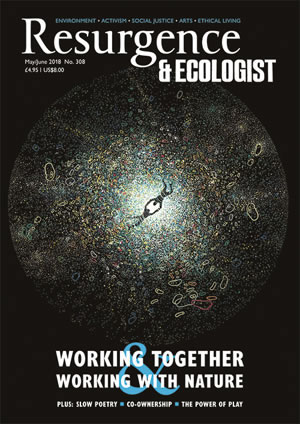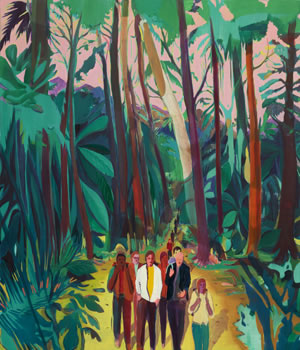When multidisciplinary artist Leah Barclay was invited to contribute to ArtCOP21 – the arts activism festival surrounding the 2015 Paris Climate Conference – she immediately knew what she wanted to do. As visitors to the Eiffel Tower ascended its four platforms, they would be simultaneously immersed in the sounds of the Amazon rainforest, recorded at four corresponding levels of the forest canopy.
Barclay achieved this using mobile technology, by ‘planting’ GPS trigger points that weaved their way up the platforms. Visitors could tap into her extraordinary sound composition simply by carrying a smartphone and a set of headphones.
The intention was to reach the busloads of delegates on tours that included the Eiffel Tower. “Many of these people were there to make decisions about the future of the Amazon rainforest, but the voice of that environment wasn’t part of those conversations,” she says.
Barclay invited human voices too, from Indigenous communities based in Peru, Brazil and Colombia, which she threaded into the installation. She also included the voices of communities she had worked with in Vanuatu – one of the countries facing the greatest threat from rising sea levels.
Five years earlier, she had made the rainforest recordings during a field trip to the Amazon. “At the time, I had no idea what I was going to use those for,” Barclay recalls. “I just thought it was important to understand what was happening at different levels of the rainforest, because the canopy was hundreds of metres above our heads. It seemed obvious that the soundscape was dramatically different up there.
“Some of the people I was working with thought it was ridiculous. They said, ‘Well, you can set up microphones on the ground and hear what’s happening up there anyway.’ But when we listened back to the recordings [made at different heights] you could hear how different it was.”
The Eiffel Tower project, known as Rainforest Listening, is indicative of Barclay’s work, which began in music composition and has since migrated into acoustic ecology. She works across environmental sciences, audio engineering, software engineering, creative arts and anthropology to form installations and performances that merge past, future and real-time people and Nature. The creative art of sound composition offers unforetold benefits to environmental sciences: it turns out that accurately recorded sound is one of the most effective forms of data for tracking changes to fragile environments in the process of climate change.
Having worked at Arizona State University and New York University, and at UNESCO Asia-Pacific on a project called Biosphere Soundscapes, Barclay has returned to Australia, where her undergraduate studies began – Griffith University’s Queensland Conservatorium of music in Brisbane. Here she carries out post-doctoral research and teaching, and is formulating new interdisciplinary courses.
It was at the Queensland Conservatorium that she began working with William Duckworth and Nora Farrell, a New York-based composer/producer team, in 2007. Their composition iOrpheus left a lasting legacy. Using new mobile phone technology, they created a performance combining live music and site-specific sound installation.
“I came into the field of acoustic ecology as a composer and performer,” Barclay recalls. “But in parallel, I was working a lot in conservation, and engaged in all of these different forums where many people were saying, ‘We need better tools to engage people in the environment; no one’s responding to messages that scientists are putting out into the world.’
“I thought, there seems to be a real potential to combine both these worlds.”
The initial piece was an exhibition for the opening of the Queensland Great Walks at a gallery on the Sunshine Coast. “Gallery staff were saying that people were getting the information and going out to the Great Walks. It was a trigger to inspire people to go to that environment and experience it. And people were donating to conservation groups related to the walks.
“So from that point almost 15 years ago, I was just sold on that idea. I thought, this is it, because if these kinds of performances and installations that I’m engaged with have some kind of scientific grounding and a conservation focus, and they can trigger that engagement for people, then why would I do anything else?”
Within her large-scale projects, Barclay has created youth engagement programmes, while Sonic Explorers is a workshop model for field recording and interacting with the environment through mobile technologies and sound.
“I was trying to inspire this culture of listening with the idea that, if we’re listening to the environment, we’re more engaged with the environment, and if we’re more engaged, hopefully that inspires communities to take action and start responding to climate change,” she says. “I realised it was important to work with people who were younger. And I was finding that 6- to 12-year-olds involved in these workshops would get really engaged.”
She tells of one group of about 40 students transforming, from an attitude of disrespect and destruction, to wonder and awe. “We went through just an hour of blindfolded sound walks, field recording, and engaging with one of these installations. Just within an hour, you could see they were treading lighter and engaging with the environment in a completely different way.”
Barclay has discovered that this way of listening to the environment is simply common sense to people indigenous to the places where she has worked, including Vanuatu, and Kabi Kabi Country on Australia’s Sunshine Coast.
The power of sound is in its capacity to provide a visceral experience of an environment. Instead of viewing images of a dying ocean reef, an audience can hear the desolation and compare it to the auditory experience of a healthy, bustling ecosystem. The power also is in its accuracy and integrity as a form of data. Rather than using invasive and relatively inaccurate electrofishing and capture-and-release methods, scientists using sound recordings can gather a clearer picture of an ecosystem’s health, without disturbing the environment.
Barclay has armed citizen scientists too, providing low-cost recording equipment to communities who can capture GPS-specific information. This creates a form of accountability. For instance, a community in the Amazon has captured the sound of chainsaws in an area claimed to be safe from logging.
Acoustic ecology emerged out of Simon Fraser University in Vancouver, British Columbia, in the late 1960s. “My research positions acoustic ecology as an inclusive, interdisciplinary field that can help us understand the rapid social, cultural and ecological changes taking place across the globe,” Barclay says. “It embraces the emerging scientific possibilities of ecoacoustics and draws on the foundations of sound studies in arts and humanities, and the value of Indigenous knowledge systems.”
Barclay is a key member of the team bringing this year’s Ecoacoustics Congress to Brisbane from 24 to 28 June. The event is a collaboration between the World Forum for Acoustic Ecology and the International Society of Ecoacoustics. For Barclay, it is an exhilarating prospect.
For more details about the Ecoaccoustics Congress visit www.ecoacousticscongress.org and www.leahbarclay.com
Justine Reilly is a freelance writer.







